Your Yard Is Your Pollinator Garden
Author: Catherine Bollinger
Pollinator gardens have been all the buzz among gardening publications for about the last 25 years. The trend started with the promotion of so-called butterfly gardens, and really took off when certain new non-native plants, such as butterfly bush (Buddleia spp. and now considered invasive!) showed up in the horticulture trade. After all, who doesn’t like seeing pretty butterflies floating from flower to flower in their yard?
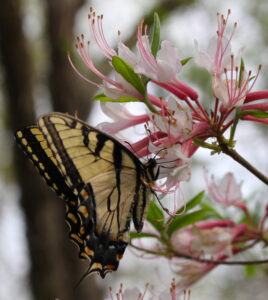 Eastern tiger swallowtail on pinxterbloom azalea.
Eastern tiger swallowtail on pinxterbloom azalea. But a quarter-century ago, neighborhoods in North Carolina were often still adjacent to fields and woodlands full of the plants that naturally occur in our region. An Eastern Tiger Swallowtail, for example, could find plenty of food sources for its caterpillars in nearby woodlands, while the adult butterflies drifted into neighborhoods to drink nectar from home gardens. However, these days, the native trees used as food by these caterpillars may well be too far from a so-called pollinator flower garden.
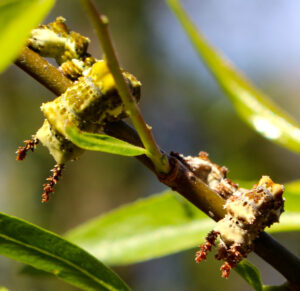 Viceroy butterfly caterpillars on willow tree.
Viceroy butterfly caterpillars on willow tree. In the region served by New Hope Audubon, rapid urbanization and a quantum increase in non-native invasive plants have eliminated most of the native fields and forests that abounded just a few decades ago. A significant uptick in the use of pesticides and herbicides in residential areas and farms, and the use of systemic insecticides in plants sold by the traditional horticulture industry, has created even more challenges to native wildlife being rapidly displaced by these changes. Pollinator flower gardens – even those dominated by native plants – cannot begin to compensate for the massive habitat loss now facing native animals, including insects, birds, amphibians, reptiles, and mammals.
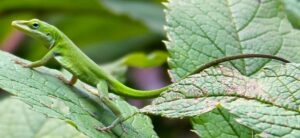 Anole lizard on Joe Pye Weed.
Anole lizard on Joe Pye Weed. To save our native animals and plants, to preserve – and create – healthy environments, a paradigm shift is required. Suburban yards and urban green spaces must be re-imagined.
Your Yard is Not Your Living Room
Unfortunately for our native plants and animals, most gardening magazines remain dominated by 20th century thinking. Glossy photographs still feature immaculate lawns edged by artfully arranged, meticulously manicured borders often full of the standard, usually non-native plants produced and sold by the horticulture industry. Articles wax poetic about traditional designs and plants – rose gardens, all-white flower gardens, fragrance gardens. They describe plant choices and designs the way interior decorators talk about rooms, often even calling for outdoor rooms. This implication that outdoor spaces should remain as static and aesthetically consistent as indoor spaces still dominates much of the traditional horticulture industry, the real estate industry, and also many home-owners associations (HOAs).
The New American Landscape
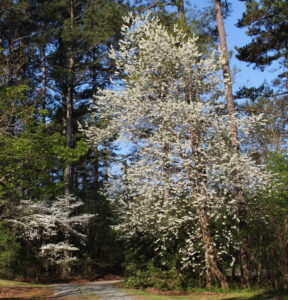 Siverbell tree and young flowering dogwood.
Siverbell tree and young flowering dogwood. To save our native animals and plants, we must re-imagine suburban and urban green spaces to create dynamic life-filled habitats. From canopy-sized trees to understory trees, shrubs, flowers, and grasses, every plant added to home and urban landscapes should serve an ecological purpose. When choosing plants, ask yourself questions like:
- What native animals will eat this plant (leaf, flower, fruit, seed)?
- What native animals will use this plant for shelter or as a nesting site?
This new American landscape aesthetic should uniquely reflect the ecology of its regions and microclimates. Pond- and stream-sides should use plants adapted to those growing conditions. Dry hilltops should look different from cooler north-facing slopes. Naturally occurring wetter areas, such as those that occur at the bottoms of hills, should feature plants adapted to those conditions.
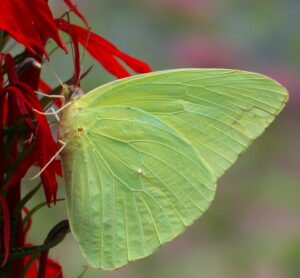 Cloudless sulphur on cardinal flower.
Cloudless sulphur on cardinal flower. This new American aesthetic should eschew shrubs carved into squares and spheres in favor of those with natural branching structures. This is easy to do if you plan for a plant’s eventual mature size, so that you won’t need to prune it into submission to conform to an allotted space.
Non-native lawns should be reduced or replaced with groupings of mostly native trees, shrubs, and flowers that will provide food and shelter for native wildlife. Such landscape choices will reduce homeowner costs for water, fertilizer, herbicides, and maintenance chores, leaving time to enjoy the many birds, butterflies, and other wildlife attracted to newly created healthy habitats. Fallen leaves should be left around trees and shrubs to enrich soils and provide habitat for the many insects with larval forms that require such places.
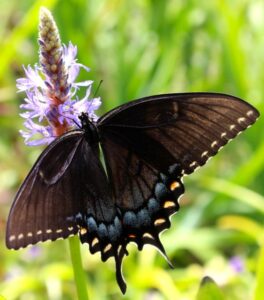 Eastern black swallowtail on pickerel weed.
Eastern black swallowtail on pickerel weed. Even small suburban lots can adopt this new American landscape that acknowledges that all green spaces must serve pollinators and other wildlife if we are to save them from extinction. If every homeowner in a suburb planted at least one canopy tree species – an oak or hickory, for example – over time, the entire neighborhood would provide a tree canopy layer that would feed and shelter much native wildlife, emulating the naturally occurring forests that once grew abundantly in the region.
As this new American landscape full of native plants and animals takes shape, suburban and urban green spaces will become complete pollinator gardens. Food sources for caterpillars and other plant-eaters will be abundantly available. Nearby blooming native flowers and shrubs will attract the beautiful adult forms of butterflies and moths we all enjoy seeing. Our yards and green spaces will become the true pollinator gardens native wildlife needs to survive, while human occupants reap the benefits of cleaner water via reduced erosion and pollution runoff, and cleaner air and cooler summer climates via the presence of abundant native trees and other plants. For wildlife and humans, it’s a win-win situation.
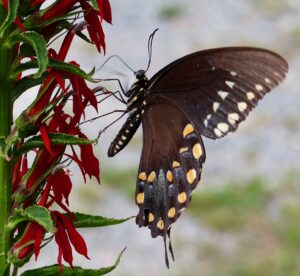 Spicebush swallowtail on lobelia.
Spicebush swallowtail on lobelia. Expert Advice Available
To get started on turning your entire yard into a pollinator garden, consider applying for bird-friendly habitat certification from New Hope Audubon. For a modest fee, their experts will visit your property to assess its value as habitat for native wildlife, provide you with suggestions to improve it, and even return at a later date to assess your progress at no additional cost.
You can also consult the expert advice provided by these resources:
- US Forest Service: Gardening for Pollinators
- Smithsonian Institution: Pollinator Garden
- Xerces Society: Pollinator Conservation in Yards and Gardens
- Ecological Landscape Alliance: More than Just a Pollinator Garden
- The Million Pollinator Garden Challenge: The Million Pollinator Garden Challenge Meets its Mark
- University of Georgia Extension Service: Beyond Butterflies:Gardening for Native Pollinators
- North Carolina Botanical Garden: Creating Your Butterfly Garden
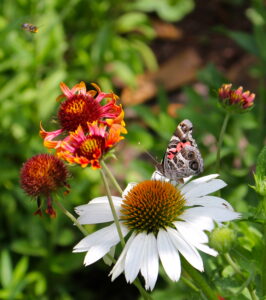 American Lady on coneflower.
American Lady on coneflower. About the Author – Catherine Bollinger is a lifetime resident of North Carolina, a professional writer, and an ardent gardener for over 50 years. Her degrees from Duke University include a Masters of Environmental Management. You’ll find her latest article, “Easy Native Wildflowers for your Home Landscape,” in the upcoming fall edition of Conservation Gardener, the magazine of the North Carolina Botanical Garden.
Photos by author.
« Back to All Press